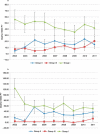Trends in non-communicable disease mortality among adult residents in Nairobi's slums, 2003-2011: applying InterVA-4 to verbal autopsy data
- PMID: 25377336
- PMCID: PMC4220149
- DOI: 10.3402/gha.v7.25533
Trends in non-communicable disease mortality among adult residents in Nairobi's slums, 2003-2011: applying InterVA-4 to verbal autopsy data
Abstract
Background: About 80% of deaths from non-communicable diseases (NCDs) occur in developing countries such as Kenya. However, not much is known about the burden of NCDs in slums, which account for about 60% of the residences of the urban population in Kenya. This study examines trends in NCD mortality from two slum settings in Nairobi.
Design: We use verbal autopsy data on 1954 deaths among adults aged 35 years and older who were registered in the Nairobi Urban Health and Demographic Surveillance System between 2003 and 2011. InterVA-4, a computer-based program, was used to assign causes of death for each case. RESULTS are presented as annualized cause-specific mortality rates (CSMRs) and cause-specific mortality fractions (CSMFs) by sex.
Results: The CSMRs for NCDs did not appear to change significantly over time for both males and females. Among males, cardiovascular diseases (CVDs) and neoplasms were the leading NCDs--contributing CSMFs of 8 and 5%, respectively, on average over time. Among females, CVDs contributed a CSMF of 14% on average over time, while neoplasms contributed 8%. Communicable diseases and related conditions remained the leading causes of death, contributing a CSMF of over 50% on average in males and females over time.
Conclusions: Our findings are consistent with the Global Burden of Disease 2010 study which shows that communicable diseases remain the dominant cause of death in Africa, although NCDs were still significant contributors to mortality. We recommend an integrated approach towards disease prevention that focuses on health systems strengthening in resource-limited settings such as slums.
Keywords: Kenya; cause of death; interval; mortality; non-communicable diseases; sub-Saharan Africa; verbal autopsy.
Figures


References
-
- Global Burden of Disease. WHO Press; 2008. Available from: http://www.who.int/healthinfo/global_burden_disease/ [cited 15 March 2012].
-
- World Health Organization. Geneva: WHO; 2011. Global status report on non-communicable diseases 2010.
-
- Di Cesare M, Khang YH, Asaria P, Blakely T, Cowan MJ, Farzadfar F, et al. Inequalities in non-communicable diseases and effective responses. Lancet. 2013;381:585–97. - PubMed
Publication types
MeSH terms
Grants and funding
LinkOut - more resources
Full Text Sources
Other Literature Sources
